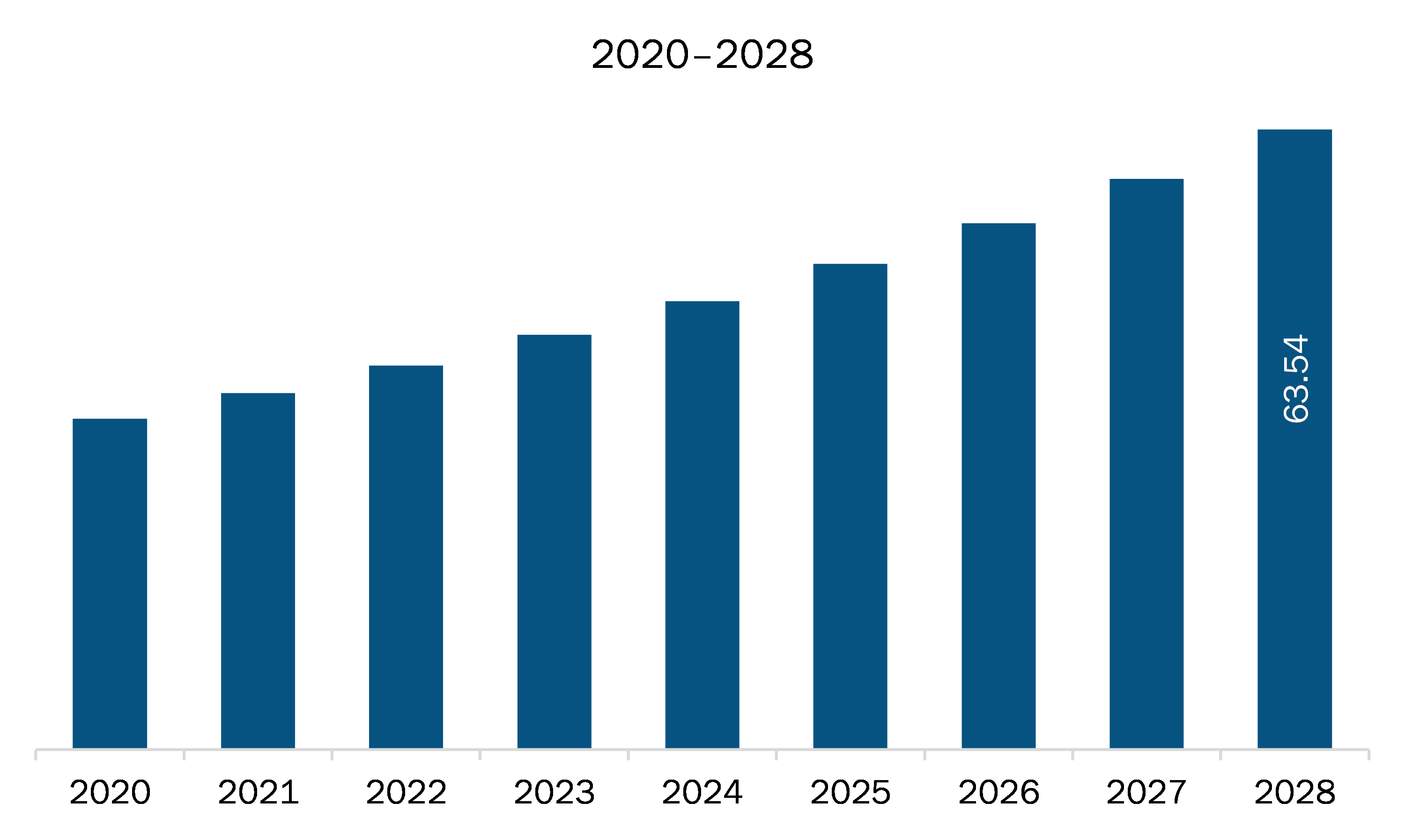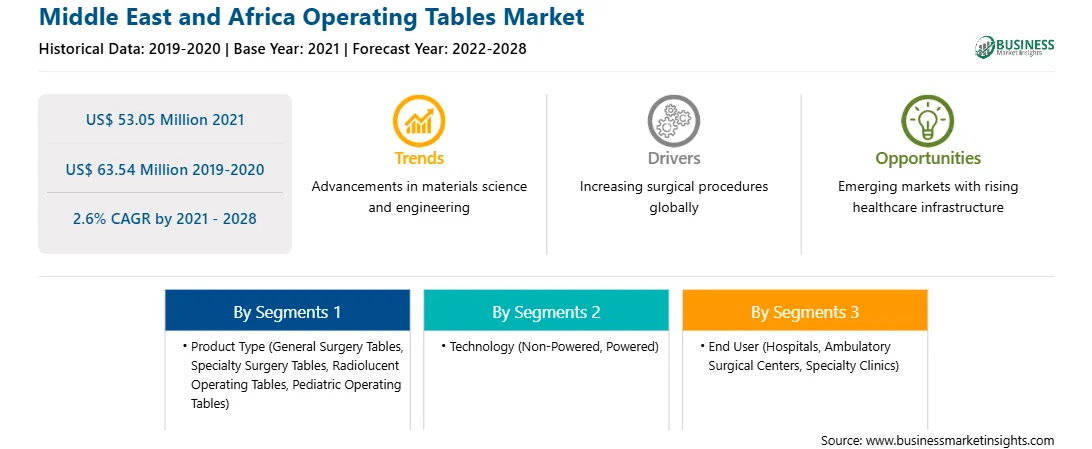The Middle East and Africa operating tables market is a highly fragmented market with the presence of considerable regional and local players providing numerous solutions for companies investing in the market arena. The demand for the operating tables is likely to grow significantly owing to the considerably increasing number of surgeries, and the need for improved treatment options are catalyzing market growth along with increasing healthcare expenditure and the developments of the healthcare facilities. For instance, as per the Dubai Health Authority, the number of surgical operations performed in DHA hospitals in 2017 was 26,000, with an average of 2,208 monthly operations. The increasing prevalence of chronic diseases and the increasing number of surgical procedures are driving the operating tables market demand. According to the World Heart Federation, 2017, cardiovascular diseases accounted for 18% of all deaths in South Africa. One in 3 South African adults (33.7%) have hypertension, increasing the risk of heart attack, heart failure, kidney disease, or stroke. Further, surgeons in South Africa prefer minimally invasive surgeries over traditional surgeries. Also, the number of accidents has increased in South Africa, the demand for surgical devices is increasing.
In the Middle East & Africa, South Africa reported a massive number of COVID-19 cases, which led to the discontinuation of several business operations, including operating table manufacturing activities. The tightened financial condition is decreasing the economic activities in the region. Since the beginning of 2020, the COVID-19 pandemic has caused enormous health, social and economic impacts, which is likely to continue in 2021. Even after some of these impacts have been mitigated or contained, there will be medium and longer-term consequences. The pandemic has caused disruptions to health services and has impacted the ability of countries to address and respond to non-communicable diseases (NCDs). Moreover, economic uncertainties and ongoing conflicts are worsening the condition in the region. However, gradually hospitals have started resuming elective procedures as the COVID-19 recovery rate is increasing. Thus, the demand for medical equipment like operating tables is expected to increase in the near future.

Strategic insights for the Middle East and Africa Operating Tables provides data-driven analysis of the industry landscape, including current trends, key players, and regional nuances. These insights offer actionable recommendations, enabling readers to differentiate themselves from competitors by identifying untapped segments or developing unique value propositions. Leveraging data analytics, these insights help industry players anticipate the market shifts, whether investors, manufacturers, or other stakeholders. A future-oriented perspective is essential, helping stakeholders anticipate market shifts and position themselves for long-term success in this dynamic region. Ultimately, effective strategic insights empower readers to make informed decisions that drive profitability and achieve their business objectives within the market.

| Report Attribute | Details |
|---|---|
| Market size in 2021 | US$ 53.05 Million |
| Market Size by 2028 | US$ 63.54 Million |
| Global CAGR (2021 - 2028) | 2.6% |
| Historical Data | 2019-2020 |
| Forecast period | 2022-2028 |
| Segments Covered |
By Product Type
|
| Regions and Countries Covered | Middle East and Africa
|
| Market leaders and key company profiles |
The geographic scope of the Middle East and Africa Operating Tables refers to the specific areas in which a business operates and competes. Understanding local distinctions, such as diverse consumer preferences (e.g., demand for specific plug types or battery backup durations), varying economic conditions, and regulatory environments, is crucial for tailoring strategies to specific markets. Businesses can expand their reach by identifying underserved areas or adapting their offerings to meet local demands. A clear market focus allows for more effective resource allocation, targeted marketing campaigns, and better positioning against local competitors, ultimately driving growth in those targeted areas.

The operating tables market in Middle East and Africa is expected to grow from US$ 53.05 million in 2021 to US$ 63.54 million by 2028; it is estimated to grow at a CAGR of 2.6% from 2021 to 2028. The types of electric operating tables continue to increase, including five-section eccentric columns, built-in kidney bridges, C-arm carbon fiber catheter operating tables, etc., These types are convenient and safe, comprehensive functions, high control precision, and long service life. The power control source is used to operate various settings, such as table movement, table tilt, and height adjustment. It helps simplify the task of an operation without distracting the surgeon's attention. This feature can be used for electric operating tables. With the help of the remote control to assist the operation of the electric actuator, the movement of a table can be easily controlled. For example, the KME-1204 sliding top electric OT from Koinaa Medical Equipments is suitable for various surgeries, such as general surgery; cardiovascular surgery; neurology, gynecology, urology, proctology, and traumatic surgery; plastic surgery; and laparoscopy. The table is equipped with remote control for easy height adjustment; side tilt; longitudinal sliding; and trendelenburg, flexion, and reflex positioning. Also, the nonreflecting surface is antibacterial and easy to clean. Owing to the plenty of power, smooth and quiet movement, multiple value-added features, and unlimited customization options (such as customized positioning), companies continue to add value to the electric adjustment of advanced operating tables. Therefore, it is expected that during the forecast period, a significant shift toward powered surgical tables will become a trend owing to the benefits offered by powered surgical tables.
Based on product type, the general surgery tables segment accounted for the largest share of the Middle East and Africa operating tables market in 2021. Based on technology, the non-powered segment accounted for the largest share of the Middle East and Africa operating tables market in 2021. Based on end user, the hospitals segment accounted for the largest share of the Middle East and Africa operating tables market in 2021.
A few major primary and secondary sources referred to for preparing this report on the Middle East and Africa operating tables market are company websites, annual reports, financial reports, national government documents, and statistical database, among others. Major companies listed in the report include Skytron, LLC; AGA Sanitätsartikel GmbH; ALVO; Getinge AB; Merivaara; Stryker Corporation and Hill Rom Holding Inc.
The Middle East and Africa Operating Tables Market is valued at US$ 53.05 Million in 2021, it is projected to reach US$ 63.54 Million by 2028.
As per our report Middle East and Africa Operating Tables Market, the market size is valued at US$ 53.05 Million in 2021, projecting it to reach US$ 63.54 Million by 2028. This translates to a CAGR of approximately 2.6% during the forecast period.
The Middle East and Africa Operating Tables Market report typically cover these key segments-
The historic period, base year, and forecast period can vary slightly depending on the specific market research report. However, for the Middle East and Africa Operating Tables Market report:
The Middle East and Africa Operating Tables Market is populated by several key players, each contributing to its growth and innovation. Some of the major players include:
The Middle East and Africa Operating Tables Market report is valuable for diverse stakeholders, including:
Essentially, anyone involved in or considering involvement in the Middle East and Africa Operating Tables Market value chain can benefit from the information contained in a comprehensive market report.